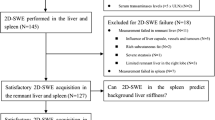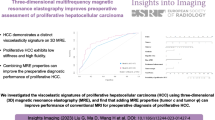Abstract
Objectives
To assess the value of the viscoelastic parameters in the characterisation of liver tumours at MR elastography.
Patients and methods
Ninety-four patients with liver tumours >1 cm prospectively underwent MR elastography using 50-Hz mechanical waves and a full three-directional motion-sensitive sequence. The model-free viscoelastic parameters (the complex shear modulus and its real and imaginary parts, i.e. the storage and loss moduli) were calculated in 72 lesions after exclusion of cystic, treated or histopathologically undetermined tumours.
Results
We observed higher absolute shear modulus and loss modulus in malignant versus benign tumours (3.38 ± 0.26 versus 2.41 ± 0.15 kPa, P < 0.01 and 2.25 ± 0.26 versus 1.05 ± 0.13 kPa, P < 0.001, respectively). Moreover, the loss modulus of hepatocellular carcinomas was significantly higher than in benign hepatocellular tumours. The storage modulus did not differ significantly between malignant and benign tumours. The area under the receiver-operating characteristic curve of loss modulus was significantly larger than that of the absolute shear modulus and storage modulus when comparing malignant and benign lesions.
Conclusions
The increased loss modulus is a better discriminator between benign and malignant tumours than the increased storage modulus or absolute value of the shear modulus.
Key Points
• Magnetic Resonance elastography is a new method of assessing the liver.
• Increased loss modulus is an indicator of malignancy in hepatic tumours.
• Loss modulus is a better discriminator than absolute shear modulus values.
• The viscoelastic properties of lesions offer promise for characterising liver tumours.





Similar content being viewed by others
Abbreviations
- |G*|:
-
Absolute value of the complex-valued shear modulus
- G′:
-
Storage modulus
- G″:
-
Loss modulus
- HCC:
-
Hepatocellular carcinoma
- FNH:
-
Focal nodular hyperplasia
- ICC:
-
Intraclass correlation coefficient
- MR:
-
Magnetic resonance
- ROI:
-
Region of interest
- ROC:
-
Receiver-operating characteristics
- AUROC:
-
Area under the receiver-operating characteristic curve
References
Taouli B, Losada M, Holland A, Krinsky G (2004) Magnetic resonance imaging of hepatocellular carcinoma. Gastroenterology 127:S144–152
Bahirwani R, Reddy KR (2008) Review article: the evaluation of solitary liver masses. Aliment Pharmacol Ther 28:953–965
Bruegel M, Holzapfel K, Gaa J et al (2008) Characterization of focal liver lesions by ADC measurements using a respiratory triggered diffusion-weighted single-shot echo-planar MR imaging technique. Eur Radiol 18:477–485
Silva AC, Evans JM, McCullough AE, Jatoi MA, Vargas HE, Hara AK (2009) MR imaging of hypervascular liver masses: a review of current techniques. Radiographics 29:385–402
Kudo M (2010) Will Gd-EOB-MRI change the diagnostic algorithm in hepatocellular carcinoma? Oncology 78:87–93
Bruix J, Sherman M (2005) Management of hepatocellular carcinoma. Hepatology 42:1208–1236
Muthupillai R, Lomas DJ, Rossman PJ, Greenleaf JF, Manduca A, Ehman RL (1995) Magnetic resonance elastography by direct visualization of propagating acoustic strain waves. Science 269:1854–1857
Sinkus R, Tanter M, Xydeas T, Catheline S, Bercoff J, Fink M (2005) Viscoelastic shear properties of in vivo breast lesions measured by MR elastography. Magn Reson Imaging 23:159–165
Asbach P, Klatt D, Schlosser B et al (2010) Viscoelasticity-based staging of hepatic fibrosis with multifrequency MR elastography. Radiology 257:80–86
Sinkus R, Lorenzen J, Schrader D, Lorenzen M, Dargatz M, Holz D (2000) High-resolution tensor MR elastography for breast tumour detection. Phys Med Biol 45:1649–1664
Huwart L, Peeters F, Sinkus R et al (2006) Liver fibrosis: non-invasive assessment with MR elastography. NMR Biomed 19:173–179
Yin M, Talwalkar JA, Glaser KJ et al (2007) Assessment of hepatic fibrosis with magnetic resonance elastography. Clin Gastroenterol Hepatol 5:e1202
Huwart L, Sempoux C, Vicaut E et al (2008) Magnetic resonance elastography for the noninvasive staging of liver fibrosis. Gastroenterology 135:32–40
Venkatesh SK, Yin M, Glockner JF et al (2008) MR elastography of liver tumors: preliminary results. AJR Am J Roentgenol 190:1534–1540
Manduca A, Oliphant TE, Dresner MA et al (2001) Magnetic resonance elastography: non-invasive mapping of tissue elasticity. Med Image Anal 5:237–254
Mariappan YK, Glaser KJ, Ehman RL (2010) Magnetic resonance elastography: a review. Clin Anat 23:497–511
Bavu E, Gennisson JL, Couade M et al (2011) Noninvasive in vivo liver fibrosis evaluation using supersonic shear imaging: a clinical study on 113 hepatitis C virus patients. Ultrasound Med Biol 37:1361–1373
Ronot M, Bahrami S, Calderaro J et al (2011) Hepatocellular adenomas: accuracy of magnetic resonance imaging and liver biopsy in subtype classification. Hepatology 53:1182–1191
Bruix J, Sherman M, Llovet JM et al (2001) Clinical management of hepatocellular carcinoma. Conclusions of the Barcelona-2000 EASL conference. J Hepatol 35:421–430
Bruix J, Sherman M (2011) Management of hepatocellular carcinoma: an update. Hepatology 53:1020–1022
Sinkus R, Tanter M, Catheline S et al (2005) Imaging anisotropic and viscous properties of breast tissue by magnetic resonance-elastography. Magn Reson Med 53:372–387
Padhani AR, Liu G, Koh DM et al (2009) Diffusion-weighted magnetic resonance imaging as a cancer biomarker: consensus and recommendations. Neoplasia 11:102–125
Zweig MH, Campbell G (1993) Receiver-operating characteristic (ROC) plots: a fundamental evaluation tool in clinical medicine. Clin Chem 39:561–577
DeLong ER, DeLong DM, Clarke-Pearson DL (1988) Comparing the areas under two or more correlated receiver operating characteristic curves: a nonparametric approach. Biometrics 44:837–845
International Working Party (1995) Terminology of nodular hepatocellular lesions. Hepatology 22:983–993
Fahey BJ, Nelson RC, Bradway DP, Hsu SJ, Dumont DM, Trahey GE (2008) In vivo visualization of abdominal malignancies with acoustic radiation force elastography. Phys Med Biol 53:279–293
Cho SH, Lee JY, Han JK, Choi BI (2010) Acoustic radiation force impulse elastography for the evaluation of focal solid hepatic lesions: preliminary findings. Ultrasound Med Biol 36:202–208
Tseng Y, Fedorov E, McCaffery JM, Almo SC, Wirtz D (2001) Micromechanics and ultrastructure of actin filament networks crosslinked by human fascin: a comparison with alpha-actinin. J Mol Biol 310:351–366
Giancotti FG, Ruoslahti E (1999) Integrin signaling. Science 285:1028–1032
Weaver VM, Roskelley CD (1997) Extracellular matrix: the central regulator of cell and tissue homeostasis. Trends Cell Biol 7:40–42
Bilston LE (2002) The effect of perfusion on soft tissue mechanical properties: a computational model. Comput Methods Biomech Biomed Engin 5:283–290
Fukumura D, Jain RK (2007) Tumor microvasculature and microenvironment: targets for anti-angiogenesis and normalization. Microvasc Res 74:72–84
Gialeli C, Theocharis AD, Karamanos NK (2011) Roles of matrix metalloproteinases in cancer progression and their pharmacological targeting. FEBS J 278:16–27
Siegmann KC, Xydeas T, Sinkus R, Kraemer B, Vogel U, Claussen CD (2010) Diagnostic value of MR elastography in addition to contrast-enhanced MR imaging of the breast-initial clinical results. Eur Radiol 20:318–325
Garteiser P, Doblas S, Daire J-L, et al (2011) Combining biomechanical and diffusion data into a composite biomarker for the determination of hepatic tumor malignancy. Proceedings of the 2011 conference of the European Society of Magnetic Resonance in Medicine and Biology 28
Mariappan YK, Rossman PJ, Glaser KJ, Manduca A, Ehman RL (2009) Magnetic resonance elastography with a phased-array acoustic driver system. Magn Reson Med 61:678–685
Asbach P, Klatt D, Hamhaber U et al (2008) Assessment of liver viscoelasticity using multifrequency MR elastography. Magn Reson Med 60:373–379
Berry GP, Bamber JC, Armstrong CG, Miller NR, Barbone PE (2006) Towards an acoustic model-based poroelastic imaging method: I. Theoretical foundation. Ultrasound Med Biol 32:547–567
Berry GP, Bamber JC, Miller NR, Barbone PE, Bush NL, Armstrong CG (2006) Towards an acoustic model-based poroelastic imaging method: II. experimental investigation. Ultrasound Med Biol 32:1869–1885
Klatt D, Hamhaber U, Asbach P, Braun J, Sack I (2007) Noninvasive assessment of the rheological behavior of human organs using multifrequency MR elastography: a study of brain and liver viscoelasticity. Phys Med Biol 52:7281–7294
Konofagou EE, Harrigan TP, Ophir J, Krouskop TA (2001) Poroelastography: imaging the poroelastic properties of tissues. Ultrasound Med Biol 27:1387–1397
Author information
Authors and Affiliations
Corresponding author
Electronic supplementary material
ESM Fig. 5
T2-weighted images, loss modulus (G″) maps and time-resolved maps of displacement in the horizontal direction of metastasis (A, D and G), HCC (B, E and H) and FNH (C, F and I). The loss modulus of HCC (2.89 kPa) is higher than that of the FNH (0.49 kPa) (PPTX 1081 kb)
Rights and permissions
About this article
Cite this article
Garteiser, P., Doblas, S., Daire, JL. et al. MR elastography of liver tumours: value of viscoelastic properties for tumour characterisation. Eur Radiol 22, 2169–2177 (2012). https://doi.org/10.1007/s00330-012-2474-6
Received:
Revised:
Accepted:
Published:
Issue Date:
DOI: https://doi.org/10.1007/s00330-012-2474-6




